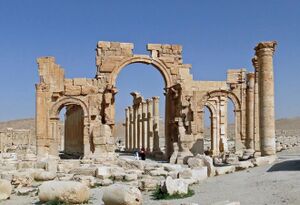Blood antiquities
Topic: Social
 From HandWiki - Reading time: 3 min
From HandWiki - Reading time: 3 min

Blood antiquities are archaeological artefacts that have been plundered during conflicts and have been used to fund these wars. The looting of archaeological sites and the illicit trafficking of cultural property is, and has been, a common practice for terrorist groups in war zones. The pieces mostly end up on the black market, art galleries and antique shops in Europe and North America,[2] or in millionaire private collections. The looting of blood antiquities especially affects the Middle East, because it is a very conflictive area and at the same time with a great density of archaeological sites.[3]
By country
Iraq
During the 2003 Invasion of Iraq, major robberies occurred at the National Museum of Iraq. Around 50,000 pieces were quantified, 25% of all the museum's heritage.[4]
The Archaeological Institute of America estimates that the revenue from looted antiquities is between $ 10 and $ 20 million annually.[5] Terrorist and rebel groups have a long history of using stolen artifacts to finance their operations.[6]
Syria
During the Syrian Civil War, the Islamic State (ISIS) carried out the systematic looting of historical sites as the main form of profit,[7] after the oil business. It is estimated that the ISIS has occupied around 4,500 sites and that the income derived from the antiquities trade amounts to an amount of 100,000,000 USD annually.[8] The terrorist organization even has an internal institution dedicated to this illegal trade.[7]
Yemen
In Yemen, blood antiquities are financing the Civil War that the country has been suffering since 2015. The Antiquities Coalition (AC) published a report in 2019 in which it is estimated that, in the country's museums alone, 1,631 historical objects have disappeared. Namely, the Aden National Museum, the Taiz National Museum and the Zinjibar National Museum; that's not counting the many archaeological sites like Shabwa.[9] The illicit trafficking of these pieces is one of the main forms of financing for terrorist groups such as Al-Qaeda in the Arabian Peninsula (AQAP) and the Houthi movement.[10]
See also
- Expoliation of Peruvian cultural property during the War of the Pacific (es)
References
- ↑ John, Mark (2015-06-10). "'Blood antiquities': a wound the world struggles to staunch" (in en). Reuters. https://www.reuters.com/article/us-mideast-crisis-antiquities-analysis-idUSKBN0OQ16320150610.
- ↑ "Les antiquités du sang : quels acteurs pour le trafic des œuvres d'art ?" (in fr). 2020-01-15. https://www.imarabe.org/fr/rencontres-debats/les-antiquites-du-sang-quels-acteurs-pour-le-trafic-des-oeuvres-d-art.
- ↑ Colwell, Chip (2016-06-10). "Speaking out against blood antiquities" (in en). Science 352 (6291): 1285. doi:10.1126/science.aaf9132. ISSN 0036-8075. PMID 27284185. Bibcode: 2016Sci...352.1285C. https://www.science.org/doi/10.1126/science.aaf7386.
- ↑ Intxausti, Aurora (2003-04-15). "El saqueo viola la cuna de la civilización" (in es). El País. ISSN 1134-6582. https://elpais.com/diario/2003/04/16/cultura/1050444001_850215.html.
- ↑ Rothfield, Lawrence (2009). The rape of Mesopotamia : behind the looting of the Iraq Museum. Library Genesis. Chicago : University of Chicago Press. pp. 138. ISBN 978-0-226-72945-9. http://archive.org/details/rapemesopotamiab00roth.
- ↑ Rothfield, op. cit. p. 132
- ↑ 7.0 7.1 "Le trafic des antiquités du sang ou le pillage par Daech du 15 avril 2016 - France Inter" (in fr). 15 April 2016. https://www.franceinter.fr/emissions/le-zoom-de-la-redaction/le-zoom-de-la-redaction-15-avril-2016.
- ↑ "La lutte infinie contre les antiquités du sang" (in fr). 4 March 2016. https://www.franceculture.fr/emissions/le-billet-economique/la-lutte-infinie-contre-les-antiquites-du-sang.
- ↑ Jarus, Owen (2019). "'Blood Antiquities' Looted from War-Torn Yemen Bring in $1 Million at Auction" (in en). https://www.livescience.com/65641-yemen-blood-antiquities-investigation.html.
- ↑ "Public's Help Needed to Recover "Blood Antiquities"". 2019-03-06. https://theantiquitiescoalition.org/publics-help-needed-to-recover-blood-antiquities/.
External links
 |
 KSF
KSF